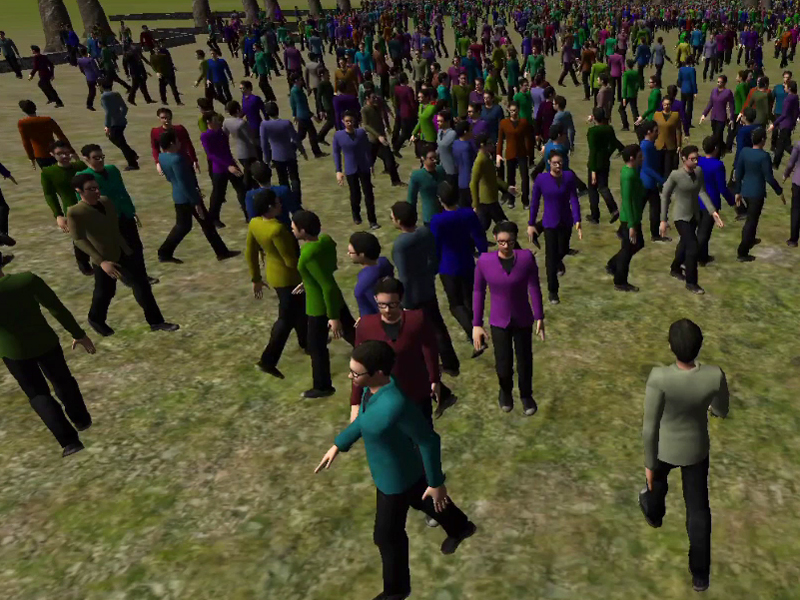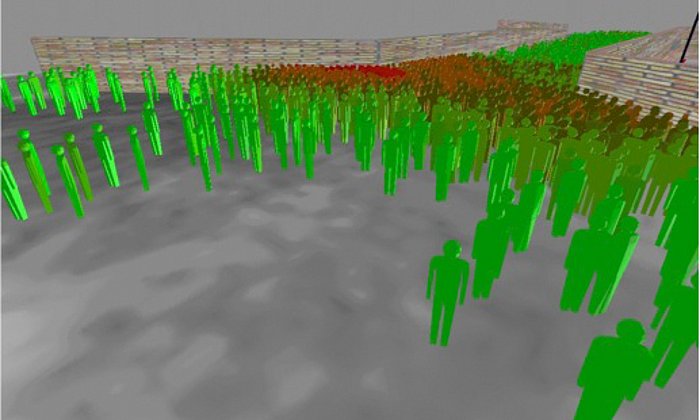Simulation of flows of people increases the security at major events
Virtual visitors track down security loopholes

The ban of backpacks, a fence, entrance access controls - the planned security measures for the Oktoberfest 2016 caused a lot of controversy months in advance. To what extent are controls necessary? When will they be perceived as a limitation casting a shadow over the mood? And what are the conditions under which the security measures are a hazard themselves because they are narrowing the escape routes?
The security at major events is not only a public issue but are also an issue for scientists. In the project MultikOSi (multicriterial integration for openness and safety) mathematicians, computer scientists and social scientists examine in joint cooperation how flows of people are moving and how they can be controlled.
Visitors as a mathematical model
"In our simulations, we describe flows of people as a mathematical model'", explains Prof. André Borrmann of the Chair of Computational Modelling and Simulation (CMS) at the Technical University of Munich (TUM). "With this model we are able to visualize, where barriers are occurring, where there is a congestion of people or where they are hindering each other because they are moving into opposite directions."
One of the researchers' most important aims is to track down the points at which congestions and obstructions are occurring. Crowds can quickly result in a live-threatening chaos – this has become evident with the disaster at the 2010 Loveparade in Duisburg, Germany. At that time, 21 visitors were killed and more than 500 were injured.
Major events as a model
To calculate the movement of tens of thousands of individuals at a major event in advance, is a real challenge as the individual's behavior is influenced by manifold elements: the location of the event space, the possibilities for arrival and departure, the number and placement of the stalls, show businesses, dance floors and public toilets. Security checks too can be an issue: queues are the result which can block access roads and escape routes.
The reality check
As a test for their models, the researchers used MultikOSi to create a simulation of the visitors' flows of the open-air festival "Back to the Woods" – an annual event on the campus of the TUM – and compared the result to the behavior of the real visitors.
"For this, a special technology has been developed", tells Borrmann. "During the festival, we have recorded the motion patterns of smart-phones utilizing various WiFi receivers. With the anonymous motion profiles we then could detect, where the visitors went, how long they were staying at a particular place, whether they were queuing up and whether it became somewhere crowded. By comparing these data with the mathematical models the researchers are able to see, whether the calculations were accurate. Arithmetically, we are indeed very close to the reality - whereas no one can completely predict an individual person's behavior. The simulations offer only a statistical average value", explains the Professor for Computer Sciences.
Dynamic queues
To research the behavior in more detail, a group of experts from the Munich University of Applied Science (MUAS) has evaluated videotape recordings of the "Back to the Woods" festival. "The behavior of people while queuing has surprised us", tells Dr Isabella von Sivers. "At the front part, the line-ups were straight, but in the back part they were moving strongly - so to speak: the tail is wagging with the dog." These findings by the team of Gerta Köster, Professor for Computer Science and Mathematics at MUAS, is important for the planning of an event, as everywhere, where queues can build up, enough space has to be taken into account.
Sociologists of the Technical University in Kaiserslautern, Germany, have examined in the project MultikOSi, which effect the waiting experience has on the mood: visitors of the festival were questioned, how they experienced the access controls and how secure they felt.
Simulation for the practical experience
Organizers of major events can now use the new models for their planning work. "The simulations can be integrated directly into computer tools for the event companies. With these, they are able to run an event virtually, to detect lineups in good time and to perform changes in the structure", sums Borrmann up. "Thereby, the security can be increased without flawing the fun at the event."
Theoretically, the researchers can simulate the Oktoberfest in Munich with this method too – due to the enormous number of visitors, however, a huge computational effort would be necessary.
The results of the MultiKOSi project will be presented by the team on the International Conference on Pedestrian and Evacuation Dynamics from 17 to 21 October 2016 in Hefei, China.
The Chair CMS is part of the the Center of Digital Methods for the Built Environment, Leonhard Obermeyer Center, which was founded in 2013 to bundle the TUM-wide expertise in the field of digital planning and construction.
Publications
- Kielar, Peter M.; Borrmann, André: Modeling pedestrians’ interest in locations: A concept to improve simulations of pedestrian destination choice, Simulation Modelling Practice and Theory 61, pp. 47-62, 2016; DOI: 10.1016/j.simpat.2015.11.003
- Biedermann, D. H.; Kielar, P. M.; Borrmann, A.: Oppilatio - The Forecast of Crowd Congestions on Street Networks During Public Events, in: Proc. of the TGF 2015, Delft, Netherlands, 2015; http://www.cms.bgu.tum.de/publications/2015_Biedermann_TGF.pdf (pdf; 1,05 MB)
- Handel, O.; Borrmann, A.: The relationship between the waiting crowd and the average service time, in: Proceedings of the 11. Conference on Traffic and Granular Flow, Delft, The Netherlands, 2015
http://www.cms.bgu.tum.de/publications/2015_Handel_TGF.pdf (pdf; 307,39 KB) - Seitz, M.; Seer, S.; Klettner, S.; Handel, O.; Köster, G.: How do we wait? Fundamentals, characteristics, and modeling implications, in: Proc. of the TGF 2015, Nootdorp, The Netherlands, 2015; http://www.cms.bgu.tum.de/publications/2015_Seitz_TGF.pdf (pdf; 158,84 KB)
- Handel, O.; Biedermann, D. H.; Kielar, P. M.; Borrmann, A.: A System Dynamics based perspective to help understanding the managerial big picture in respect of urban event dynamics, In: Proc. of the 7th Conference on Pedestrian and Evacuation Dynamics, Delft, The Netherlands, 2014; http://www.cms.bgu.tum.de/publications/2014_Handel_TRP.pdf (pdf; 244,01 KB)
Highresolution pictures: mediatum.ub.tum.de/1325866
Contact
Prof. Dr.-Ing. André Borrmann
Technical University of Munich
andre.borrmann@tum.de
Tel: +49 89 289-23047
Christiane Taddigs-Hirsch
Munich University of Applied Sciences
christiane.taddigs-hirsch@hm.edu
Tel. +49 89 1265-1911
